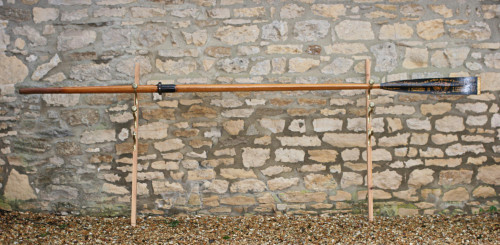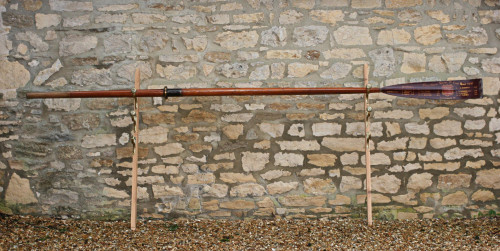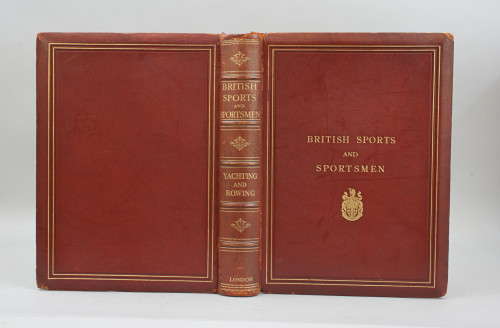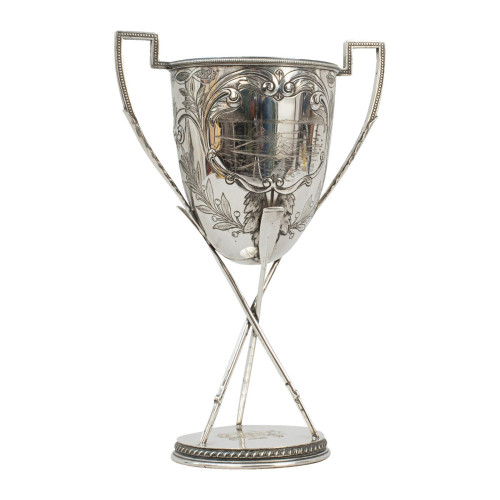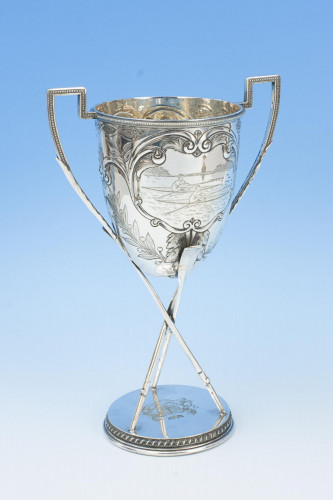- Home
- Rowing & Yachting
- Rowing Oar, Queen's College Eight 1920
Rowing Oar, Queen's College Eight 1920
Rowing Oar, Queen's College Eight 1920
29857
Rowing Oar Blade, Queen's College Eight 1920, Oxford University.
The full-length oar is an original traditional Queen's College Eight (Oxford University) presentation rowing oar with gilt calligraphy and college insignias. The writing on the trophy blade is in good condition. It is a beautiful oar and in original condition with no repaint or repairs. The calligraphy denotes the crew's names, weights and bumps.
The trophy blade reads:-
'Queen's College Eight - 1920'
Bow. G.T. Millward. 10.1.
2. O. Sturt. 12.0.
3. F.Leach. 12.2.
4. G.S.H. Carter. 12.0.
5. P.C. Mallam. 11st. 7lbs.
6. C.W. Arning. 11.13.
7. E.P.B. Pryor. 11.2.
Str. E.A. Berrisford. 11.0.
Cox. M.G. LeFleming. 7st. 5lbs.
Bumped - Lincoln, Pembroke, Ch.Ch.II, Corpus.
We believe this oar belonged to P.C. Mallam as we purchased another oar at the same time which also has his name on it. He rowed for the dark blues in the Oxford and Cambridge University boat race four times, 1921, 1922, 1923 and 1924, only being on the victorious side of the 75th Boat Race in 1923. He wrote a book 'Rowing' in 1949 with a co-rower, Guy Oliver Nickalls. Nickalls also rowed for the dark blues in 21, 22, and 23 and competed in the 1920 Summer Olympics and in the 1928 Summer Olympics. He was a member of the Leander Boat Club (as was Mallam) and took part in the 1923 Toronto International Regatta for Leander with Mallam and six others to win the Eight oared Race in 1923.
As the oar is full length (12 foot) shipping can be quite expensive. We have come up with an ingenious way to cut the oar so as to make shipping cheaper, the oar can then be easily reassembled. One of the images shows different images of an oar that has been cut down. It is cut by the leather sleeve so the joint is less visible or obvious. The oar can then be bolted together to make the oar one solid piece.
Please do enquire about the different shipping options.
Any crew which records four consecutive bumps is said to have 'gained their oars'. The prize being a full-size oar decorated with the names of the full crew in gold lettering on the college colours for each rower. The cox is given a decorated rudder and the coach receives a decorated wooden shield with a mock-up of the bow end of a boat.
Both Oxford and Cambridge Universities host two university bumps races yearly, each lasting several days. The races are for eights (i.e. eight rowers and a cox), each representing one of the university's various colleges. One of the races is held in early spring and the other in early summer, in Oxford they are called 'Torpids' in the spring and 'Eights' in the summer, in Cambridge these are called 'Lent Bumps' and 'May Bumps'. The leading crews of the Lent Bumps go on to race the leading Oxford Torpids crews at the Henley Boat Races around Easter.
The first attested bumps race took place in Oxford in 1815 and was between two eights from Brasenose College and Jesus College. Twelve years later Lent Bumps racing commenced at Cambridge University. As the Isis and Cam are long narrow rivers, not ideal for normal side by side racing, Bumps racing evolved. The competing crews line up bow-to-stern in order, one behind the other with gaps of about 1½ boat lengths between them. The start of the race commences with the firing of a cannon, the idea to progress up their division by attempting to catch and Bump (touch) the boat in front whilst simultaneously trying not to be Bumped by the boat behind. The ultimate aim becoming top of the first division and "Head Of The River". When a bump has taken place both of the crews involved in the Bump pull over to the river bank and take no further part in that race, allowing the rest of the division to pass. The only difference is in Torpids where the crew whose boat was Bumped has to continue racing (and is liable to be bumped again). It is possible to "over bump", if the 2 crews involved in the Bump have pulled over and the crew behind them manage to catch the boat that was in front of them, this is an "over bump".
Dimensions:
1900-1949
1920
Pine
United Kingdom
Calligraphy very good, one small nick on edge of blade. No visible repairs or repainting.
Thank you for your enquiry.
We will get back to you soon.
Please create wishlist to add this item to
RELATED ITEMS























